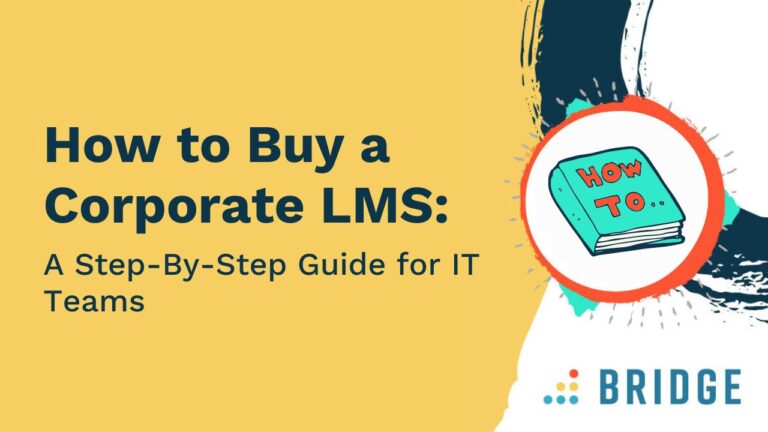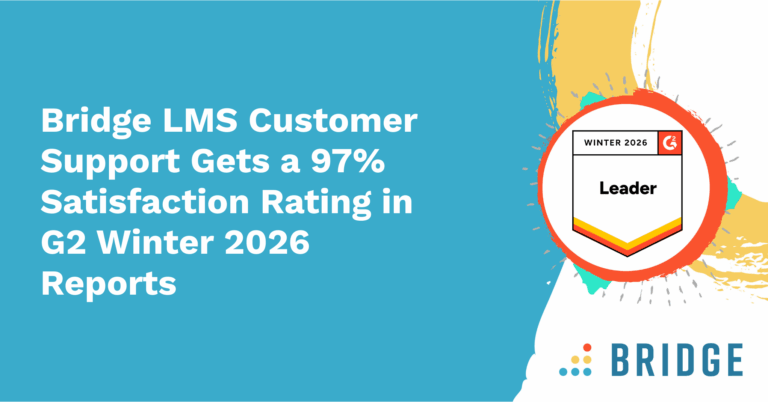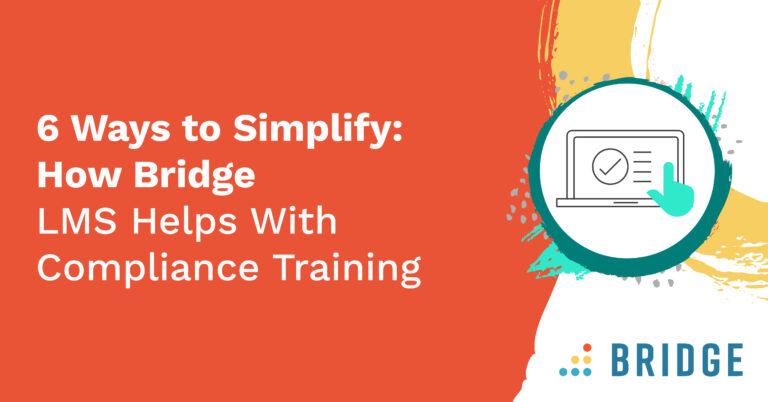As the overseers of your organization’s tech stack, you and your fellow IT team members know that researching and evaluating learning management systems and other software solutions is key to making the right purchasing decision.
According to Asana’s State of the IT Leader report, 62% of IT professionals say they’ve gained more influence in supporting business outcomes in 2024. Respondents were also more than twice as likely to say that boosting employee productivity is a top consideration compared to 2023.
Choosing the right solution for your organization and end users means working with your decision-makers to find a platform that’s easy to configure and simple for users to navigate, while being supportive of your business goals.
Read on to find out how to cement your role in procuring, implementing, and maintaining an LMS that meets the needs of your entire organization, as well as some tips on how to collaborate with key stakeholders across the business.
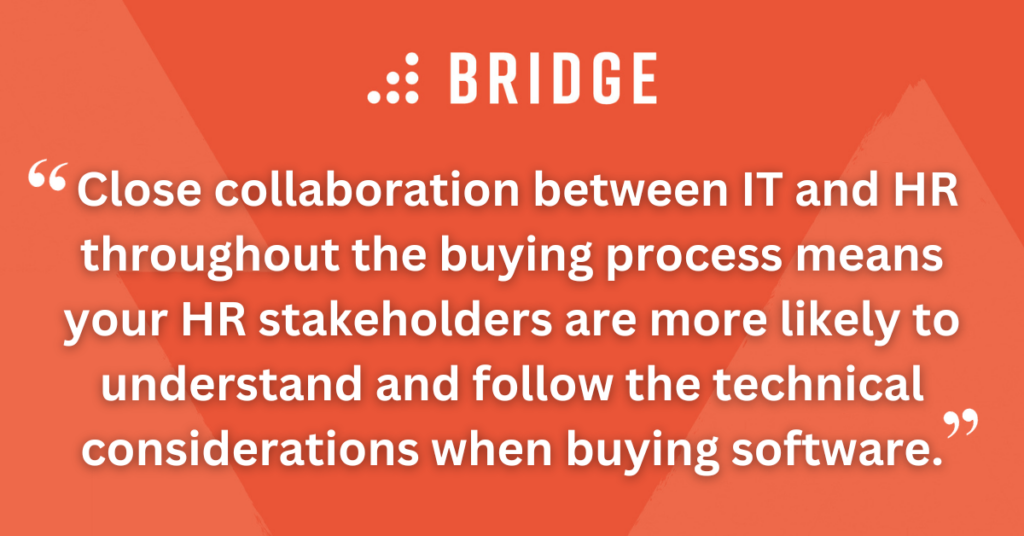
The Importance of Collaboration When Buying Tech
Here's the thing—six in ten US buyers say that they regret at least one software purchase they've made for their business. That's based on findings in the 2024 US Tech Trends Report compiled by software review company Capterra.
Among the most common reasons for purchase regret were difficulties in training and onboarding users and a complicated implementation process that affected productivity.
However, the results show organizations that take the following actions are more likely to be satisfied with a tech purchase:
- Research and evaluate vendors thoroughly
- Involve both IT and non-IT professionals in the process
- Understand the goal behind the software purchase
Close collaboration between IT and HR throughout the buying process means your HR stakeholders are more likely to understand and follow the technical considerations when buying software. Equally, when your team is clear about the purpose behind a software purchasing decision, you’re more likely to select a solution that better serves the business and end users.
In addition, partnering with your HR team during the purchasing process can support your broader business priorities. Knowing what each stakeholder needs and their involvement at each stage of the journey means you can supply them with all relevant information and reduce the risk of slowing down the buying process.
FIND OUT MORE | ‘What Is a Learning Management System (LMS), and Why Would You Need One?’
1) Identifying the Need for a Corporate LMS
Like any other solution, an LMS must add value to your business. Finding a tool that best meets your organization's requirements means identifying the need and how you can meet it with a software solution.
Understand Your Business Needs
When buying software, you're likely to be part of an internal group of decision-makers, each with your own set of priorities and perspectives. It's up to HR or L&D stakeholders to make the business case and secure buy-in for an LMS, so you can expect them to be well-informed about what they're looking for in a solution and how the right tool will help them achieve their goals.
You should make the case for your own non-negotiable software requirements and present them to your HR teams. Highlighting essential functionality such as security and the level of technical support and sharing how these requirements can influence return on investment can strengthen the business case and clarify stakeholder expectations.
To identify these needs, consider asking L&D teams and end users the following questions:
- What challenges are you facing?
- Will this purchase support business initiatives?
- Do you already have a platform in place?
- What issues or gaps exist with the current platform?
- What’s the budget?
Outline the Software Approval Process
You need the ability to oversee and manage the tools and platforms your people use. Documenting the purchasing process can set expectations and guide decision-makers as they research and engage with vendors.
Additionally, requesting a breakdown of apps and services used by each department helps reduce purchasing duplication and ensures your team maintains good information security practices. With access to this information, you'll be in the best position to offer strategic insights, such as the tools your users find valuable and the essential features to look for in a platform.
Audit Your Existing Tech Stack
It might be harder to justify an LMS if your organization already has one. However, auditing your existing tech stack presents an opportunity to find pain points and challenges that can influence buying decisions.
In particular, you'll want to check that your existing learning platform adds value to admins and authors, supports business goals, and provides a seamless experience for users. Doing so could help you find ways to slim down the number of tools and find ways to consolidate multiple applications into a single corporate LMS.
For example, you'll want to be sure that your HR tech meets the following requirements:
- Keeps your business up to date with mandatory and compliance training
- Offers visible employee data and analytics
- Provides a secure data infrastructure
- Integrates with your existing tech stack
DO YOU NEED A NEW LMS? | ‘3 Signs It Might Be Time For a New Learning Management System (LMS)’
2) Determining the Requirements for an LMS
Once you're clear about your business needs, you'll want to define the must-have features you require from a learning platform.
Specifying the mandatory and optional technical requirements for a new platform should be a collaborative exercise between HR and IT stakeholders that accounts for business-wide priorities and objectives.
Security and Compliance
Clarify the security standards your organization's tech stack currently adheres to, along with details of industry regulations and data protection measures, such as:
- Access controls and user permissions
- User authentication and authorization
- Encryption and data storage
- Multi-factor authentication
Integration With Your Existing Tech Stack
Your new platform should be compatible with the other systems used throughout your organization. Share relevant details about your organization's technical infrastructure and identify other platforms and apps that must integrate with your LMS. Consider features such as:
- SSO and authentication
- Webhooks
- APIs
- Access to other third-party tools
An Easy-to-Use Interface
Think about the features required from an LMS and how much flexibility you want admins to have in configuring and adapting the platform.
Looking for an LMS with some of the following features can create a single, easy-to-use experience for your users and reduce the level of involvement your IT team needs to have in managing and configuring the system. You may want to consider:
- Upskilling and reskilling features
- Employee development plans
- Customizable learning paths
- Performance reviews
- Built-in course authoring tools
- An intuitive reporting and analytics dashboard
Scalability and Future Growth
As your organization grows, your HR tech needs might change. Consider current and anticipated needs and whether a solution will adapt and support them. Examples of these needs include:
- The ability to increase users
- Minimum service length
- Vendor lock-in
- The ability to acquire and integrate add-on products
FIND OUT HOW TO CONSOLIDATE YOUR TECH STACK THE RIGHT WAY | ‘Consolidating Your HR Tech Stack? Here Are 3 Pitfalls to Watch Out For’
3) Evaluating LMS Providers
You don't need to be hands-on during the initial research stage. However, if you'd like to support your HR stakeholders as they compare vendors, gather third-party reviews and ratings for an unbiased assessment of the pros, cons, and overall experiences of each solution.
You may want to use some of the following channels to collect information:
- Independent software reviews
- Customer testimonials and success stories
- Events and webinars
- Online forums and communities
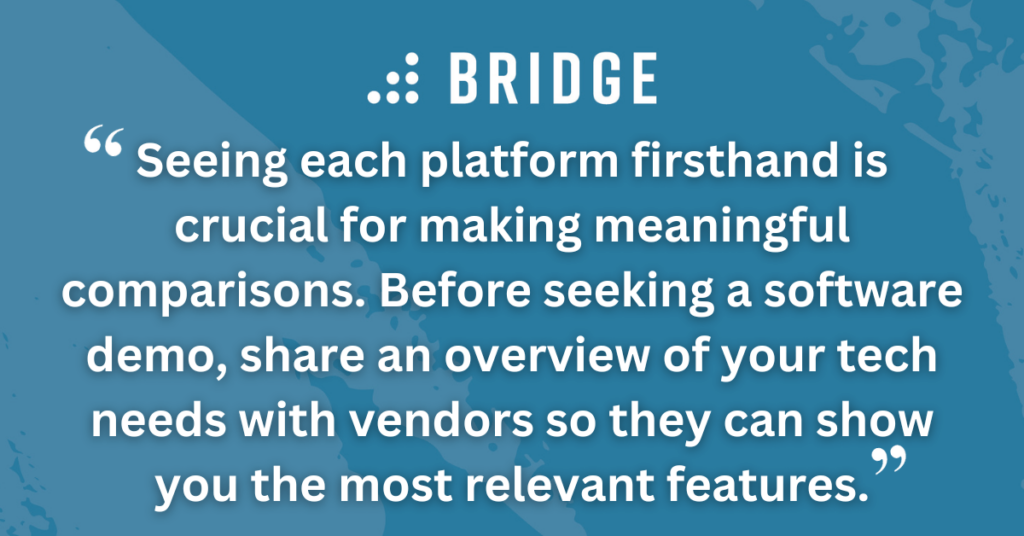
4) Assessing LMS Demos
Once you have a list of potential software providers that meet your organization's requirements, you should assist your HR buyer in narrowing down the selection. During this process, schedule time with each LMS provider to see their software capabilities for yourself.
Obtain LMS Demos
Seeing each platform firsthand is crucial for making meaningful comparisons. Before seeking a software demo, share an overview of your tech needs with vendors so they can show you the most relevant features.
It's useful for a member of your IT and L&D teams to be present during a demo. However, if it's not possible, check to see if the vendor can supply a recording or an interactive walkthrough.
Discuss Your Technical Requirements
In addition to a demo, arranging a call with the vendor's technical experts is helpful if you need additional information or want to discuss your requirements. This can allow you to cover topics such as the level of support you can expect while giving you insight into how well they understand your technical needs.
During this call, LMS providers should detail their role during implementation, how they'll work with your team once your new platform is onboarded, and any relevant documentation.
Consider the Level of Support Available
You want to know that your new LMS offers your users a robust and reliable experience, reducing the risk of business disruption and relieving the pressure on IT teams.
Review uptime guarantees, the level of support available, and response times to ensure your users have a point of contact if they run into difficulty.
Additionally, check to see if a software provider offers the following:
- A community hub with on-demand videos, support guides, and release notes
- 24/7 customer support via multiple channels, such as phone, email, live chat, or a support ticket system
- A dedicated onboarding specialist and customer success manager
SEE HOW CUSTOMERS RATE BRIDGE | ‘G2 Names Bridge a Mid-Market Leader With Highest User Adoption’
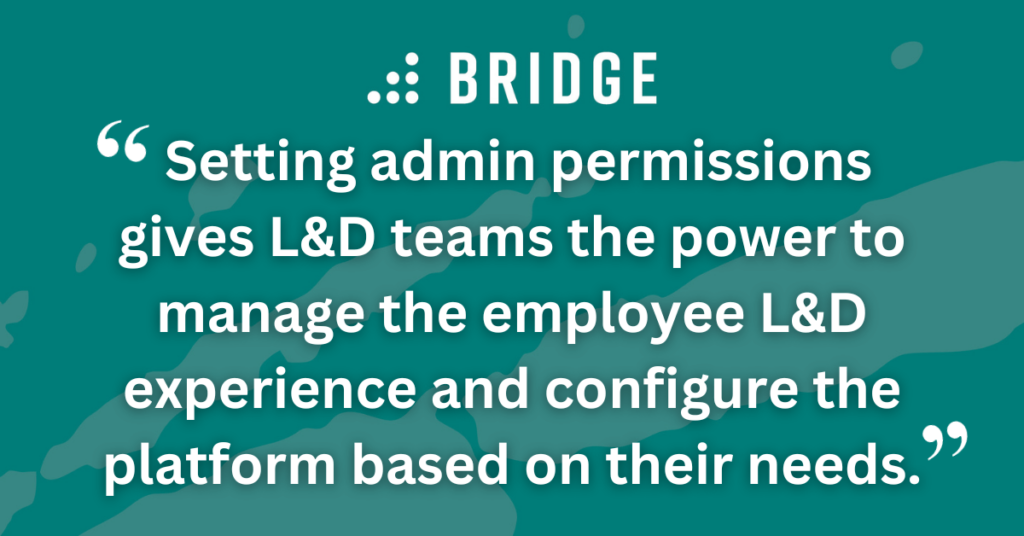
5) Implementing Your New LMS
Once your stakeholders approve the purchase and sign the contract, you play a pivotal role in the post-purchase implementation and rollout.
Signing a contract with a new LMS provider is the beginning of a long-term partnership. Your vendor should work with you and your team throughout the onboarding process and beyond to ensure the platform is configured to your needs and your users get the most out of it.
Prepare Your Existing Data
You'll work according to a project plan with tasks and deliverables outlining what you need to do at each stage when configuring your new LMS.
If you're migrating data from an existing LMS, it's essential to identify the data to be transferred and how this should be structured within your new platform.
Your software provider will work with you to map this data and check it’s migrated successfully. Your L&D team should curate content and review user data before migrating it to a new platform.
You'll also want to back up some of the following information to minimize disruption during the transfer:
- User data (including logins and permissions)
- Course content
- Learner progress (including certifications, enrollments, and completions)
Integrate Existing Systems
Depending on the configuration of your existing tech stack, you'll work with your vendor to manage your integrations.
For example, during this process, you'll set up some of the following:
- External platform integrations
- Single sign-on and authentication
- User management and provisioning
- Custom webhooks and APIs
Configure the Platform
You'll also need to set up the platform to facilitate a seamless user experience. This includes defining user roles and permissions, tailoring the user interface, and structuring content with appropriate tags and categories so employees can access the information they need.
Granting admin permissions to appropriate stakeholders gives L&D teams the power to manage the employee L&D experience and configure the platform based on their needs. For IT teams, this means you’re able to oversee crucial data and analytics without the need to provide hands-on technical support.
Ready to Take the Next Step?
Using a single, comprehensive platform for your organization's learning, development, and performance needs reduces the complexity of managing multiple systems and vendors.
Reach out to learn more about the benefits of Bridge's all-in-one offering.
